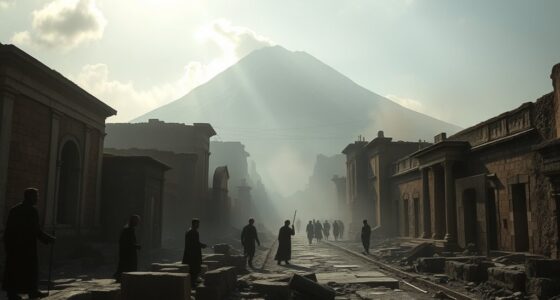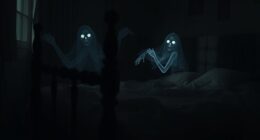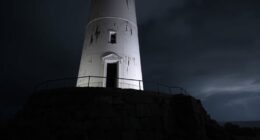The ghosts of the French Revolution linger in France’s historical landscape, echoing unresolved traumas from the Reign of Terror. These spectral figures symbolize the deep psychological scars left on survivors. You’ll find chilling locations like Mortemer Abbey, haunted by murdered monks, and the eerie Chateau De Fougeret, where familial phantoms roam. Each site tells a haunting tale that connects past violence to modern paranormal encounters. Discovering these stories can reveal much more about this turbulent era.
Key Takeaways
- The Reign of Terror (1793-1794) left a legacy of fear, creating a collective trauma reflected in ghostly symbolism in literature and art.
- “Correspondance des vivants et des morts” illustrates an exchange between a survivor and a deceased friend, symbolizing unresolved trauma from the revolution.
- Notable haunted locations, like Mortemer Abbey, are tied to historical events, with ghostly figures symbolizing the violent past and unresolved grief.
- Chateau de Fougeret, uninhabited for decades, showcases numerous ghostly encounters, highlighting the emotional legacies of past residents linked to the revolution.
- French ghost lore serves as a haunting memorial, connecting historical events with spectral inhabitants, reflecting society’s struggle with its violent history.
The Legacy of the Reign of Terror

The Reign of Terror, which unfolded between 1793 and 1794, left a haunting legacy that continues to resonate in French culture.
You can see how the trauma from this period shaped the collective consciousness, as mass executions and imprisonment instilled a deep-seated fear among the populace.
Survivors of the Terror grappled with psychological scars, marking their lives with an enduring sense of loss and unresolved grief.
The era’s ghostly symbolism, particularly in works like “Correspondance des vivants et des morts,” serves as a reminder of these traumatic memories.
Additionally, the phantasmagoria shows of 1797 projected images of victims, further illustrating society’s struggle to confront the violent legacy of the Reign of Terror.
The echoes of this dark time still linger today.
Correspondance Des Vivants Et Des Morts: a Haunting Exchange
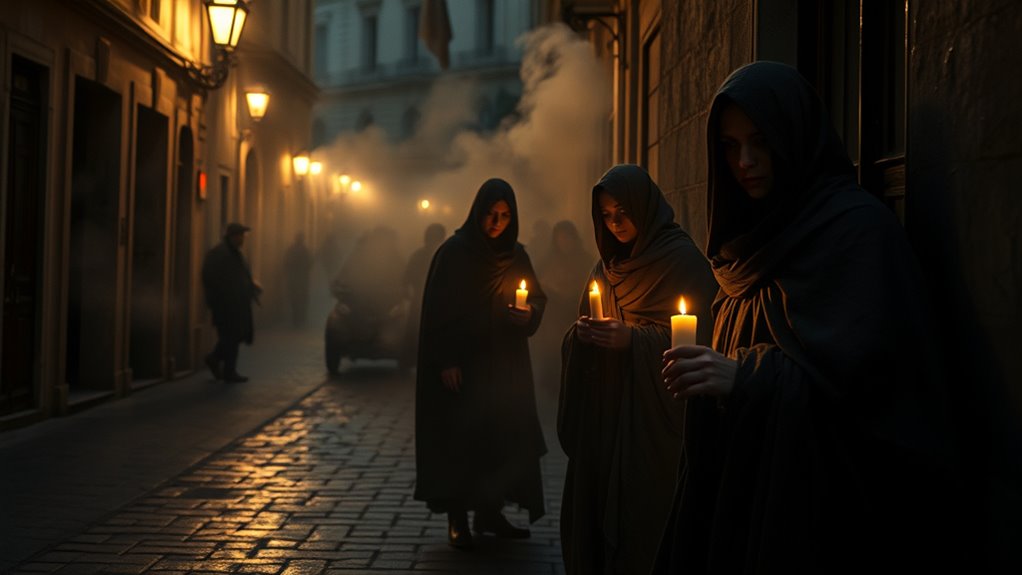
Emerging from the trauma of the Reign of Terror, “Correspondance des vivants et des morts” captures the eerie interplay between the living and the dead.
This anonymous pamphlet features letters exchanged between a survivor of the French Revolution and a deceased friend, highlighting their pact for justice.
The quivering letters symbolize unresolved trauma, illustrating how the past haunts the present. As the survivor wrestles with their experiences, the ghosts disrupt linear time, revealing the concept of impossible knowledge.
Understanding these traumatic events becomes possible only through temporal distance, offering a way to process the brutal realities of the Reign of Terror.
Temporal distance allows for the understanding of trauma, providing a pathway to confront the brutal realities of the Reign of Terror.
Ultimately, the pamphlet serves as a haunting medium, confronting historical events that refuse to fade away.
The Role of Ghosts in French Culture
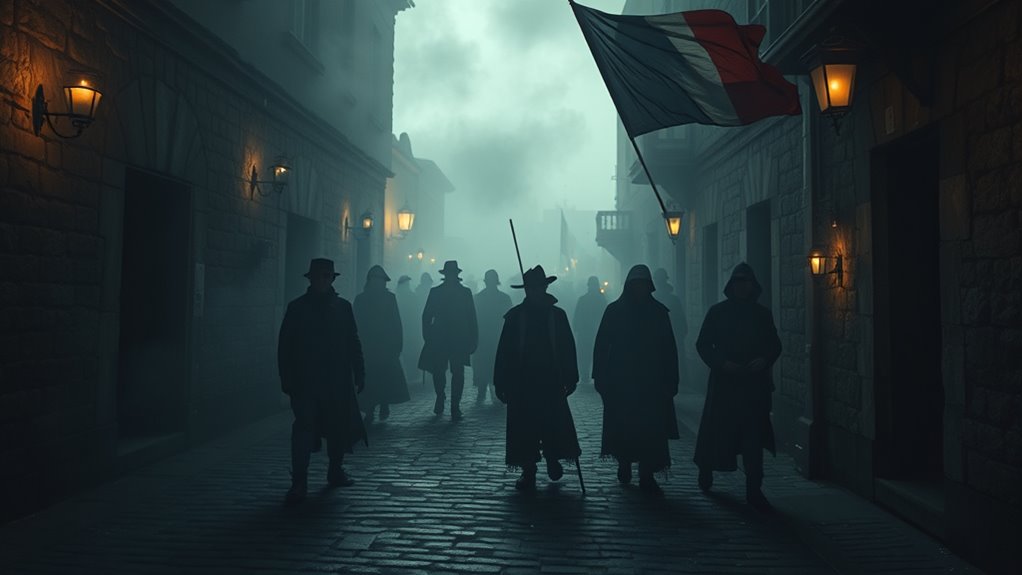
In French culture, ghosts serve as powerful symbols of unresolved trauma and the shadows of history.
You’ll find that these spectral figures not only haunt the narratives of the past but also reflect the nation’s struggle with its violent legacy.
From the eerie tales of revenants to the haunting memories evoked in art and literature, ghosts remain an essential part of understanding France’s complex historical identity.
Ghosts as Cultural Symbols
While many might see ghosts as mere folklore, in post-Revolutionary France, they represent profound cultural symbols tied to unresolved trauma and the haunting legacy of the Reign of Terror. The concept of revenants, or returning spirits, reflects society’s struggle to reconcile with its violent past and personal losses.
Ghost stories may not dominate mainstream culture, but they thrive in local traditions, especially outside Paris, blending rationalism with folklore. The phantasmagoria shows of the late 18th century captivated audiences with moving images of ghosts, revealing a collective memory of Terror victims.
Additionally, communication with the dead, as explored in “Correspondance des vivants et des morts,” underscores the theme of “impossible knowledge,” where understanding of trauma often comes through temporal distance.
Haunting Historical Narratives
Ghosts haunt French culture not just as spectral figures but as poignant reminders of the nation’s tumultuous history, particularly after the Revolution. They symbolize unresolved past traumas, reflecting the haunting experiences of survivors during the Reign of Terror.
The pamphlet “Correspondance des vivants et des morts” illustrates this supernatural connection, using letters between a survivor and a deceased friend to explore justice and memory. The concept of “revenants” emphasizes how these ghosts serve as a medium for discussing traumatic histories, disrupting linear perceptions of time.
Phantasmagoria shows in post-Terror Paris blended entertainment with cultural reflection, evoking memories of execution victims. This emphasis on ghosts underscores France’s struggle to reconcile its revolutionary past, shaping collective memory and echoing in contemporary society.
Notable Haunted Locations in France
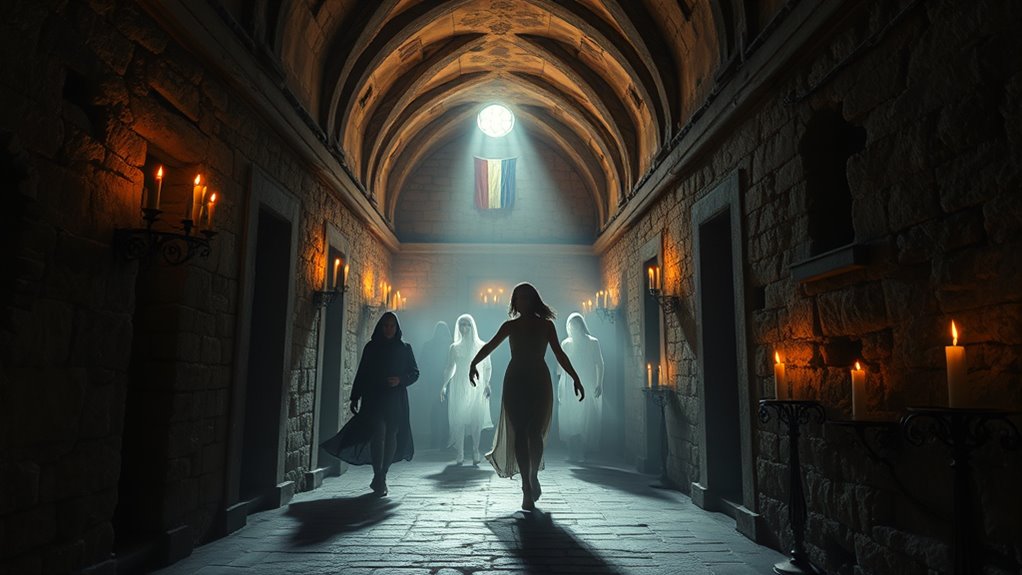
Throughout France, a tapestry of haunted locations beckons those curious about the supernatural. Mortemer Abbey stands out, steeped in legend with its ghostly monks, a chilling reminder of the four monks murdered during the Revolution.
The Dame Blanche, believed to be Empress Matilda, haunts the abbey, her appearances signaling fortune or doom.
In Pigalle, the cursed mansion at #1 Avenue Frochot whispers tales of a horrific murder, drawing in those intrigued by its paranormal phenomena.
Meanwhile, the Tevennec lighthouse in Brittany echoes with ghostly voices, urging its keepers to flee.
Finally, the Chateau de Brissac in the Loire Valley is home to the tragic spirit of Charlotte de Valois, who wanders through its grand halls on stormy nights.
The Murdered Monks of Mortemer Abbey

Four monks met a tragic fate at Mortemer Abbey in 1790, their brutal murder by revolutionaries casting a long shadow over the historic site.
This 12th-century Cistercian monastery, built on marshy land known as “dead pond,” has since become infamous for its haunted reputation.
Locals share chilling tales of the murdered monks, claiming their spirits still wander the abbey grounds.
During World War II, a benevolent ghost reportedly appeared, adding another layer to the abbey’s spectral lore.
To this day, annual ghost nights draw visitors keen to explore its haunted past, featuring candlelit tours that investigate the legends of the murdered monks.
Mortemer Abbey remains a site where history and the supernatural intertwine.
The Dame Blanche: A White-Clad Apparition
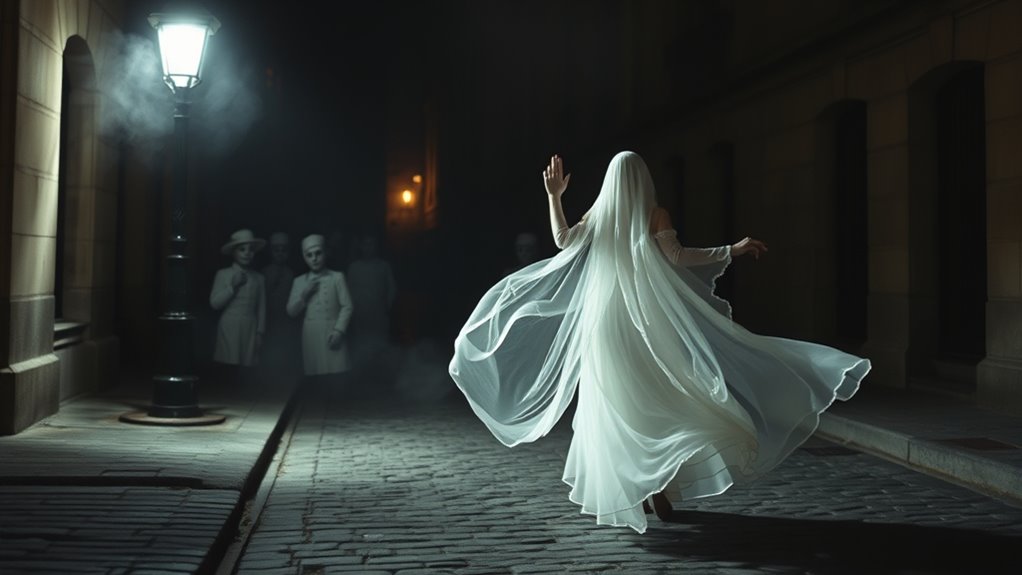
While exploring the eerie grounds of Mortemer Abbey, you might encounter the enigmatic figure known as the Dame Blanche, a white-clad apparition believed to be the spirit of Empress Matilda of England. Legend has it that her appearance foretells either death or good fortune, depending on the color of her gloves. This haunting echoes the unresolved traumas of the French Revolution, adding depth to the Abbey’s spectral reputation.
| Feature | Details |
|---|---|
| Appearance | White clothing, ghostly presence |
| Symbolism | Foretells death or good fortune |
| Historical Ties | Linked to Empress Matilda |
| Local Events | Annual ghost nights at the Abbey |
Join the candlelit tours and explore the legends surrounding the Dame Blanche.
The Cursed Mansion in Pigalle

If you find yourself wandering through the vibrant streets of Pigalle, watch out for the ominous Cursed Mansion at #1 Avenue Frochot, notorious for its dark past.
Linked to a horrific unsolved murder of a servant, this cursed mansion is said to carry a lingering haunting that torments its inhabitants. Eerie sounds echo throughout the halls, and misfortune seems to shadow those who reside there.
Notable figures like composer Victor Massé and theatre critic Matthieu Galey met untimely ends from the same disease after living there. Even actress Sylvie Vartan felt an unsettling presence and quickly sold the mansion.
With Pigalle’s history steeped in the occult, it’s no wonder this place remains one of Paris’s most haunted locations.
The Haunted Lighthouse at Tevennec

Nestled in the treacherous waters off the coast of Brittany, the Tevennec lighthouse stands as a chilling reminder of the madness that has plagued its keepers.
Built in 1875, this haunted location has seen its share of tragic deaths and eerie occurrences, particularly among married couples assigned to its duties.
Henri Guezennec, the first operator, often reported hearing ghostly voices urging him to flee his post.
The lighthouse’s dark history is further amplified by the mysterious fate of a family with children who perished under strange circumstances.
With a legacy tied to numerous shipwrecks, including the Séduisant during the Napoleonic Wars, Tevennec continues to captivate paranormal enthusiasts drawn to its ghostly tales and sinister past.
Familial Phantoms at the Chateau De Fougeret
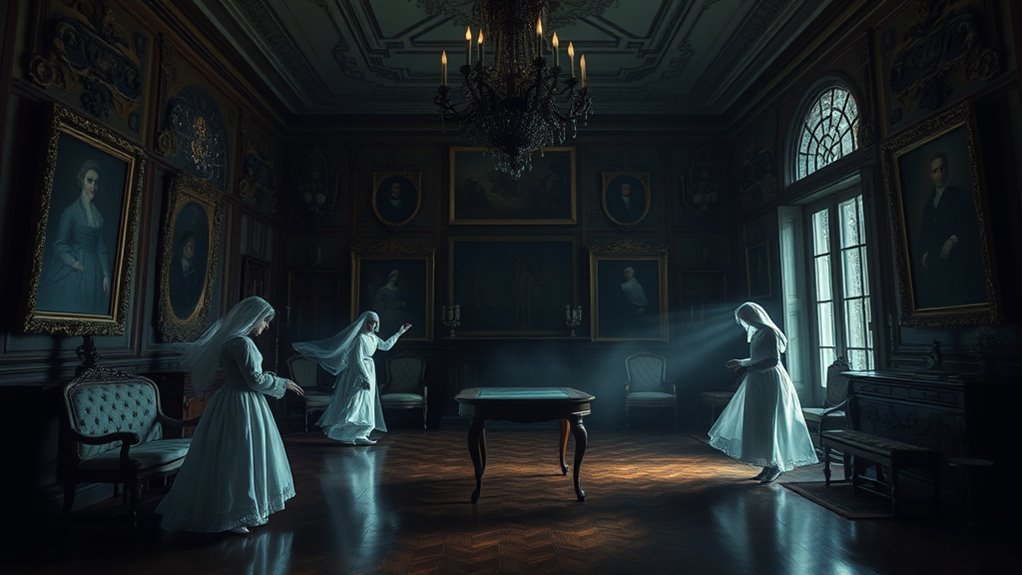
When you step into the Chateau de Fougeret, you can’t help but feel the weight of its history.
Reports of moving chairs and the sounds of family gatherings hint at a world still echoing within its walls.
With medium Lexa Marau identifying multiple spirits, the chateau offers a unique glimpse into the emotional legacies of its past inhabitants.
Historical Significance of Chateau
The Chateau de Fougeret stands as a haunting memorial to the past, steeped in history and ghostly tales. Built between the 14th and 15th centuries, its historical significance lies in how it embodies the unresolved stories of its former inhabitants.
For over 50 years, the chateau has remained uninhabited, leading to reports of moving chairs and echoes of family meals, suggesting a connection to the familial phantoms that once lived there. Medium Lexa Marau identified twelve distinct entities, including the spirit of young Alice, who died at just 22.
As the owners plan paranormal-themed tours, they aim to attract those intrigued by its haunted history, showcasing how these lingering spirits reflect the rich tapestry of French ghost lore.
Paranormal Encounters and Evidence
Although many historic sites claim to be haunted, few can match the eerie allure of Chateau de Fougeret, where reports of paranormal encounters abound.
Built between the 14th and 15th centuries, this uninhabited chateau has become a hotspot for ghostly activity. Visitors often hear sounds of family meals and witness moving chairs, suggesting a strong presence of familial phantoms.
Medium Lexa Marau identified at least twelve entities, including a spirit named Alice, who tragically died at just 22 years old in the house.
These haunting experiences spark intrigue and draw tourists enthusiastic to explore the supernatural. The interplay between history and ghostly inhabitants at Chateau de Fougeret offers a unique glimpse into the past, making it a must-visit for ghost enthusiasts.
The Ghostly Tale of Chateau De Brissac
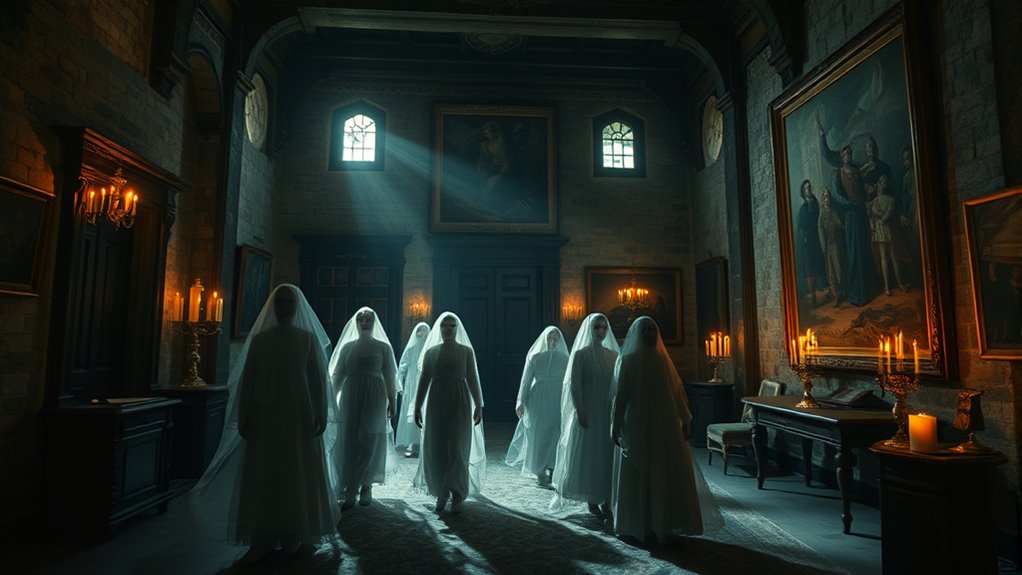
What stories lie within the walls of Chateau de Brissac, where the past intertwines with the supernatural? This majestic chateau is haunted by the ghostly figure of Charlotte de Valois, who met a tragic end at the hands of her husband in 1477.
As you wander its grand halls, you might hear whispers of her sorrow, especially on stormy nights when she’s said to appear in the chapel tower, foretelling doom.
The weight of her tale hangs heavily in the air, inviting you to explore the depths of love, betrayal, and loss.
- The chilling presence of the White-Clad Lady
- Echoes of her mournful cries
- The shadowy corners of history
- A sense of impending doom
- The allure of the unknown
Frequently Asked Questions
What Was the Horror of the French Revolution?
The horror of the French Revolution lies in the sheer brutality of its violence and the chilling atmosphere of fear it created.
You’d witness mass executions, where thousands met their fate under the guillotine, and the state targeted anyone seen as a threat.
The atmosphere was charged with paranoia, leading to the imprisonment of countless innocents.
As you navigate this turbulent time, the deep scars on society and individuals become painfully evident.
What Was the Spirit of the French Revolution?
The spirit of the French Revolution embodies the powerful ideals of liberty, equality, and fraternity that inspired radical change.
You’ll find that this fervor motivated everyday people to challenge oppression and seek justice. Fueled by Enlightenment philosophies, the revolutionaries aimed to create a society free from tyranny.
However, as you explore deeper, you’ll recognize the complexities and contradictions within these ideals, especially when faced with the harsh realities of violence and chaos during the Revolution.
Why Was the Reign of Terror so Scary?
The Reign of Terror was scary because it created an environment of paranoia where anyone could be accused of treason.
You’d witness public executions, often involving the guillotine, turning death into a spectacle.
The revolutionary government, under the Committee of Public Safety, enforced extreme measures, leading to mass arrests and executions.
With tens of thousands killed, fear gripped society, making it impossible to feel safe or trust anyone, not even your closest friends.
What Was the Terror During the French Revolution?
The Terror during the French Revolution refers to a period from 1793 to 1794 marked by extreme political repression and violence.
You’d witness the rise of the Committee of Public Safety, which targeted perceived enemies of the Revolution. Thousands faced swift trials and executions, often without substantial evidence.
The guillotine became a symbol of fear, claiming around 16,000 lives, including notable figures.
This climate of paranoia ultimately led to the downfall of its architect, Robespierre.
Conclusion
As you explore the echoes of the French Revolution, you can’t help but feel the weight of history lingering in the air. The haunted tales, like that of the ghostly monks at Mortemer Abbey, remind you that the past never truly fades. Instead, it shapes the present, weaving a tapestry of spectral stories that connect generations. Embracing these spectral encounters enriches your understanding of France’s cultural legacy, bridging the gap between the living and the departed.




